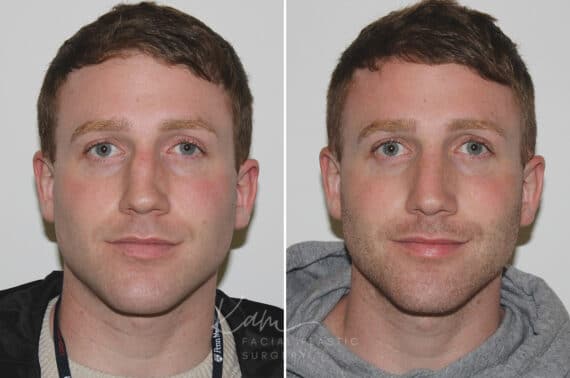Nasal obstruction, or difficulty breathing through one or both sides of the nose, is a common health issue that can significantly impact daily life. This condition can result from various causes, including structural abnormalities in the nasal airway and inflammation from allergies or sinus infections. When left untreated, nasal obstruction can lead to poor sleep quality, decreased athletic performance, and a lower overall quality of life.

Nasal Obstruction and Its Impact on Daily Life
One of the primary functions of the nose is to facilitate breathing. When this function is hindered by nasal obstruction, it can lead to many problems. Patients with nasal obstruction might have difficulty with nasal breathing, leading to mouth breathing and dry mouth and throat.
Common Causes of Nasal Obstruction
Deviated Septum
One common cause of nasal obstruction is a deviated septum. The wall dividing the right and left nasal passages is called the nasal septum. When the septum deviates, or shifts, from the midline, it can block one or both nasal passages and make breathing difficult. Symptoms of a deviated septum include nasal congestion, frequent nosebleeds, facial pain, noisy breathing, and snoring.
Nasal Polyps
Nasal polyps can obstruct breathing. They are soft, painless, noncancerous growths that develop on the nasal passages or sinus lining. They are often associated with conditions such as allergies, asthma, or chronic sinus infections. Common symptoms of nasal polyps include a runny nose, postnasal drip, persistent stuffiness, and loss of smell and taste. However, the severity of these symptoms can vary depending on the polyps’ size and the extent to which they block the nasal passage.
Allergies
Allergies can trigger inflammation and swelling of the nasal tissue, leading to nasal obstruction. This obstruction can hinder peak nasal inspiratory flow, a measure of the maximum airflow achieved through the nasal airway during inhalation. Allergens are numerous and varied substances that trigger an allergic reaction. Common allergens include dust mites, pet dander, pollen, and mold, all of which can cause a nasal response that can obstruct the nasal passage.
Chronic Sinusitis
Sinusitis lasting over 12 weeks indicates a chronic condition with ongoing sinus inflammation, termed “Chronic sinusitis”. This inflammation can block the nasal passages, leading to nasal obstruction. Symptoms of chronic sinusitis include nasal inflammation, thick, discolored discharge from the nose, congestion, pain, tenderness, and swelling around the eyes, cheeks, nose, or forehead.
When is Surgery Recommended for Nasal Obstruction?

Persistent Symptoms Despite Non-Surgical Treatments
Surgery for nasal obstruction is often considered when symptoms persist despite non-surgical medical treatments. Non-surgical treatments for nasal obstruction include avoiding allergens, taking antihistamines, decongestants, and steroids, and using nasal sprays to humidify the nose. Surgical intervention may be necessary if these treatments do not alleviate the symptoms.
Structural Abnormalities Causing Nasal Blockage
Structural abnormalities, such as a deviated/crooked septum or nasal valve collapse, can cause nasal blockage. Surgery may be recommended in such cases to correct the nasal structures and restore nasal patency.
Impact on Quality of Life and Sleep
Surgery may be recommended for chronic nasal obstruction that impacts a person’s sleep and quality of life. Obstructive sleep apnea can be corrected, and patients can avoid the consequences of insufficient sleep.
Understanding Surgical Options
Septoplasty
Septoplasty is a common procedure in the realm of nasal obstruction surgeries. This surgical intervention is specifically designed to rectify displaced or shifted septal cartilage present at birth, which might be from trauma or injury. Septum surgery will improve airflow to relieve symptoms ranging from nasal congestion to difficulty breathing.
Endoscopic Sinus Surgery
Endoscopic sinus surgery is a minimally invasive surgical technique that utilizes a thin, flexible tube with a light and camera attached to it, known as an endoscope. This procedure is primarily used to remove blockages in the sinuses, which various things, such as nasal polyps, chronic sinus infections, or hypertrophy, can cause. The surgeon inserts the endoscope into the nasal passage, allowing for a clear view of the nasal cavity and sinuses. This allows for precise removal of the blockage and improved sinus function.
Rhinoplasty
Rhinoplasty in New Jersey, or nose job, is often considered a cosmetic procedure that modifies the shape of a crooked nose. However, his procedure can address breathing function by correcting various anatomical irregularities, including a septal deviation, enlarged turbinates, or other issues with the nasal airway that impede optimal airflow. Functional rhinoplasty can be a transformative procedure for patients who have difficulty breathing due to chronic nasal obstruction.

Recovery and Post-Operative Care
The recovery process from nasal obstruction surgery is critical and requires careful management for optimal results. Patients with septal surgery, endoscopic sinus surgery, or New Jersey rhinoplasty are typically advised to rest and refrain from strenuous activities that could potentially delay the healing of the nasal tissues and cause complications.
Taking time to rest will allow the nasal passage, nasal septum, and nasal cavity to heal correctly and help restore nasal patency and peak nasal inspiratory flow.
It’s also critical to adhere to your surgeon’s post-operative care instructions. These instructions are designed to support the healing process, prevent infection, and manage any discomfort or pain before participating in any normal activity. One common recommendation is using saline nasal sprays, and prescribed medications are also often part of the care regimen after nasal surgery.
Risks and Benefits of a Nasal Obstruction Surgery
Like all surgical procedures, each type of nasal obstruction surgery carries potential risks. These risks can include infection, which can occur if bacteria enter the nasal cavity or sinuses during or after surgery, and reduce recovery time. Since the nasal passage contains many blood vessels, manipulating the nasal septum and nasal bones during surgery risks excessive bleeding.
Adverse reactions to anesthesia are also a possibility, as with any surgery, and can range from mild nausea to more serious, albeit rare, complications such as allergic reactions or breathing difficulties.
However, the benefits often outweigh the risks when a skilled surgeon performs nasal obstruction procedures. Correcting nasal abnormalities can improve a patient’s health and overall quality of life.
Get a consultation with a Nose Surgeon
Nasal obstruction is a common condition that can significantly impact daily life. Understanding the causes of nasal obstruction and the surgical options available is the first step toward finding relief.
If you’re experiencing nasal obstruction symptoms, consult a healthcare provider to discuss your treatment options. Contact Kam Facial Plastic Surgery in Voorhees and Sewell, NJ, to schedule a consultation with Dr. Joanna Kam, an experienced, board-certified otolaryngologist-head and neck surgeon who offers functional nasal and sinus surgery expertise.
